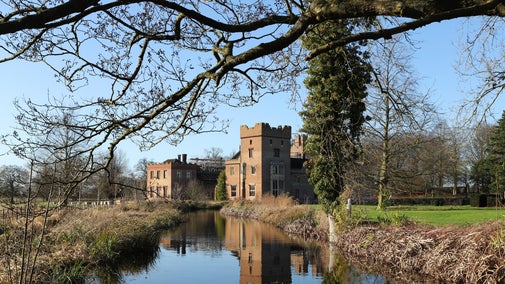
Donate
Everyone needs nature, now more than ever. Donate today and you could help people and nature to thrive at the places we care for.

If walls could talk, what would they say? Although the collection of original items at The Workhouse is small, these walls have been witness to over 150 years of history. They may not be able to tell us directly what they have seen or heard but they can show us other parts of social history. Discover how we go about caring for and conserving them.
In February 2025, the large oil portrait of Reverend John Thomas Becher, founder of The Workhouse, was carefully removed from its usual home in the Board Room and was sent away for vital conservation work to be carried out.
The portrait is over 180 years old and had begun to show signs of deterioration including flaking paint and discoloured varnish. While a certain amount of damage is unavoidable over time, careful conservation can stabilise an item to minimise damage in the future.
It was transported to Critchlow & Kukkonen conservation studios, which specialise in paintings. Flaking areas were stabilised, old varnish was replaced, and a microclimate frame was fitted to protect the surface from the effects of environmental factors, like fluctuating humidity levels.
The painting was returned to us in March and we'd like to say thank you to the team at Critchlow & Kukkonen Ltd for their careful work, and to the Dean of Southwell, who loans the portrait to the National Trust.

Inside the Infirmary there is a lot of original wallpaper that requires careful conservation and protection.
However, it’s not just the Infirmary that has unusual wallpaper. The Workhouse also has examples dating back as early as the mid-19th century – when the building was used to house paupers – right through to more modern examples from the 1970s.
To highlight how we care for this collection, The Workhouse was part of an exciting project called ‘Hands On or Hands Off?’ involving four other National Trust properties.
The project aimed to create innovative ways to engage visitors with conservation stories, and at The Workhouse it focussed on how and why we conserve the walls. In this case, it involved working with local community groups to create a new exhibition.
Local artist, Sarah Holden, helped put together a workshop for local Brownies and Guides in which participants designed and created their own wallpaper samples, using original examples from The Workhouse.
The project aimed to show how the Workhouse's wallpaper is an important part of the building’s history, whilst being an extremely fragile part of the collection. The children's work helped to show the extent of the damage caused when people and items touch this wallpaper.
- Sarah Holden - Local artist working in collaboration with The Workhouse

Smaller, individual items in the collection at The Workhouse are also conserved and cared for by our team, including:
There are currently over 1,200 items catalogued in the collection. Most of these are in protective storage, and are checked annually to ensure they are in good condition. Much of the collection is made up of historic objects, although we do have hundreds of furnishing items as well.
During the winter months, the team remove items from display and carefully store them in acid-free tissue paper boxes. This ensures their protection while checks are carried out on the empty display cases to analyse light levels, temperature and humidity - three factors that can damage objects.
With your ongoing support, we're able to continue our vital conservation work. Thank you for helping to protect these special places.

Everyone needs nature, now more than ever. Donate today and you could help people and nature to thrive at the places we care for.
Find out more about visiting The Workhouse and Infirmary, where guided tours, exhibitions and activities help bring to life the stories of the people who had to work to receive food, shelter and medical care here.

From plot to pauper plate, explore the recreated Victorian vegetable garden and admire the range of heritage varieties grown.

There are lots of ways to keep the family engaged at The Workhouse and Infirmary. With children's trails, seasonal activities, digital devices and dress up.

Take a sneak peek into the treasure trove that is the collection of The Workhouse and Infirmary and learn what these objects tell us about the history of this special place.

Read about our strategy, which focuses on restoring nature, ending unequal access and inspiring more people.

We believe that nature, beauty and history are for everyone. That’s why we’re supporting wildlife, protecting historic sites and more. Find out about our work.
